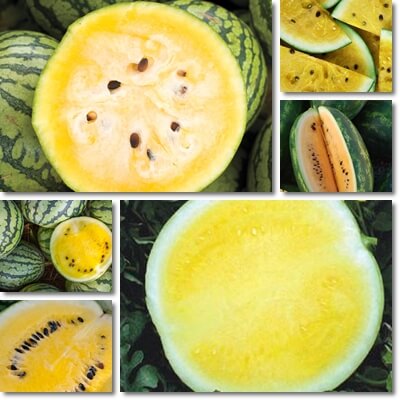Watermelon comes in many varieties, including the more common pink, red and orange fleshed watermelon, the less common green and white fleshed watermelon and the recently popular yellow fleshed watermelon. Sweet like honey and intensely flavorful, yellow watermelon is an important source of both pigmented and unpigmented antioxidants and vitamin C for healthy gums and anti-inflammatory benefits. Yellow watermelon is low in calories and provides a range of vitamins and minerals, including vitamin A, vitamins B1, B2 and B5, magnesium, phosphorus, potassium and calcium.
What does yellow watermelon look like?
From the outside, yellow watermelon is essentially indistinguishable from the more common pink-red varieties: varying in size from less than one kilogram to several, it has an oblong or rounded shape and light green rind with medium to dark green stripes varying in thickness running along the length of the fruit.
Yellow watermelon has pale yellow to golden yellow flesh, depending on variety, and is soft, juicy and fresh. Near the rind, there is a band of thicker, harder whitish-green, but edible pulp. Yellow watermelon comes in both seedless and seeded varieties, the mature seeds being brown and black and edible.

Why are yellow watermelons yellow inside?
Pink and red-fleshed watermelons are the norm, so why are some watermelons yellow inside? What causes the yellow flesh color in yellow watermelons is a significantly lower content of lycopene, the pink-red pigmented antioxidant responsible for the flesh color in pink and red watermelons, but also guava, grapefruit and red carrots. Instead, the yellow flesh color of yellow watermelon is owed to carotenoid antioxidants such as xanthophylls, notably neoxanthin, but also violaxanthin and neochrome (source).
What does yellow watermelon taste like?
There are several cultivated varieties of yellow watermelon and flavor profile may differ slightly between them. Overall, yellow watermelon is sweeter than red watermelon, almost as sweet as honey. It has delicious honey and fruity flavors and a soft, but crisp and juicy flesh, slightly denser compared to that of red watermelon. Versus red watermelon flesh which is somewhat stringy, yellow watermelon is not which adds to its appeal.
Find out more about the differences between red vs yellow watermelon.
It’s a good idea to wash your yellow watermelon with dish soap and water in the sink before cutting it to reduce risks of foodborne illness by spreading bacteria from the rind to the flesh inside.
You can also eat yellow watermelon seeds, both the immature, milky white seeds and the dark brown-black, hard-shelled mature seeds.
The seeds are a source of nutrition and provide measurable benefits for health. See the benefits of yellow watermelon seeds.
Yellow watermelon season
July-August is peak season for yellow watermelon, although it is technically available almost year-round from different regions of cultivation. However, the yellow variety is cultivated on a smaller scale so it’s not as readily accessible as red which is a source of inconsistencies and gaps in the supply chain, except for peak season in summer months when you should be able to buy it most places that also sell red watermelon.

Yellow watermelon nutritional value
Research on the nutritional value of yellow watermelon is scarce. However, despite exact nutrition facts not being available, the nutrition of the yellow-fleshed variety can be inferred from available data on the nutrition of red watermelon. Except for a few differences, the nutrition of yellow watermelon is the same as the nutrition of red watermelon.
- Source of dietary fiber (around 0.5 g of fiber/100 g)
- Low-calorie (around 50-60 kilo-calories/100 g)
- Moderate carbohydrate content (around 8-10 g of carbs/100 g)
- Moderate sugar content (around 70-75% of total carbohydrate content is represented by natural sugars)
- Good vitamin C content (averaging 10% of daily recommended values/100 g serving of the fruit)
- Modest vitamin A content from pro-vitamin A antioxidants (less than 5% of daily intake/100 g)
- Other vitamins in yellow watermelon: vitamins B1, B2, B3, B5, B6, B9, choline (less than 5% of daily intake/100 g)
- Vitamin E in the seed kernels
- No vitamin D
- Almost no vitamin K
- Minerals in yellow watermelon: calcium, copper, iron, magnesium, manganese, phosphorus, potassium, selenium, zinc (between 1-4% of daily recommended intake/100 g serving)
- Sodium-free
What are the benefits of yellow watermelon?
Hydrating food with tonic properties
With a water content of over 90% and small amounts of important electrolytes such as calcium, magnesium and potassium, yellow watermelon actively combats dehydration and exerts tonic, energizing effects. Eating yellow watermelon when it’s hot outside is good for counteraction and relieving fatigue, malaise, lethargy, brain fog and weakness associated with dehydration.
Combats oxidative stress
Source of both pigmented and unpigmented antioxidants, yellow watermelon helps prevent, limit and repair cell damage caused by free radicals and reduce associated side effects such as inflammation conducive to chronic disease development.
Benefits for the kidneys and swelling
High in water and hydrating, yellow watermelon is a strongly diuretic food which supports normal kidney function by increasing urine output. Moreover, minerals with electrolyte functions in the yellow-fleshed fruit regulate fluid levels in the body, actively combating water retention and swelling.
Good food for weight loss
Relatively low in calories and consisting mostly of water, but unprocessed and nutritious, yellow watermelon can substitute other more calorie-dense food options in your diet, helping you achieve a good calorie deficit and lose weight in a healthy manner.
Diuretic properties with benefits for water retention
Eating yellow watermelon, and all watermelon colors, ups water intake and promotes diuresis which helps balance fluid volume in the body. This helps lower blood pressure naturally and helps combat water retention and associated side effects such as swollen ankles, swollen feet, swollen legs, swollen hands, swollen arms and puffy face.
Minor benefits for blood pressure and blood circulation
Essentially sodium-free and a modest source of both potassium and magnesium, yellow watermelon contributes to lower blood pressure numbers and cardiovascular health. Bioavailable lycopene further helps improve blood pressure numbers. The white part of the watermelon rind contains good amounts of the amino acid citrulline which contributes to nitric oxide production and benefits for high blood pressure and blood circulation.
Benefits for eyesight
Eating yellow watermelon is good for vision. The content of pigmented antioxidants beta-carotene and, to a greater extent, lutein and zeaxanthin in yellow-fleshed watermelon promote the physical health of the eyes by exerting a protective antioxidant effect against radiation from sunlight.
The pigmented antioxidants in the fruit that give it its color further support visual acuity, color vision and vision in dim light, informally called night vision. Not just this, but lutein and zeaxanthin are scientifically proven to lower risks of cataract and age related macular degeneration, AMD, causing loss of central vision (source 1, source 2, source 3).
Benefits for gums and teeth
Did you know that yellow watermelon is good for gums and teeth health? A good source of vitamin C, yellow watermelon strengthens the walls of capillaries, the small blood vessels that oxygenate gums, preventing bleeding and supporting the adherence of gum tissue to teeth. This indirectly holds benefits for teeth, helping prevent teeth loss.
Moreover, studies show vitamin C lowers levels of inflammatory markers and inflammation in the body, as well as exerts antibacterial effects which further holds benefits for the health of gums and teeth, helping lower risks of gum disease and associated teeth loss.
Vitamin C in yellow watermelon also actively contributes to keeping teeth strong and healthy. Studies show vitamin C stimulates the production of collagen types 1 and 3, resulting in functional benefits related to the development and maintenance of bone tissue. Just as important, it’s directly involved in ‘regulating gene transcription in bone’ related to the the maturation and normal function of osteoblasts, cells that produce new bone tissue and regenerate bones and teeth (study).
Anti-inflammatory benefits
The anti-inflammatory benefits of yellow watermelon are owed primarily to a good content of vitamin C, but also to the good antioxidant content of the fruit flesh. How much vitamin C in yellow watermelon? A serving of 100 grams of the yellow flesh fruit can get you about 10% of your daily vitamin C values which is a good amount.
Benefits for the immune system
Owed to vitamin C, vitamin A from pro-vitamin A antioxidants and pigmented and unpigmented antioxidants in the yellow-fleshed fruit. Antioxidants and antioxidant vitamins in the fruit have antibacterial, antiviral and tissue reparative benefits that support and regulate the immune system function for a better immune system response.
Minor benefits for the nervous system
The benefits of yellow watermelon for the nervous system are owed primarily to a range of B vitamins, namely vitamins B1, B2, B3, B5, B6 and B9. B vitamins both support nervous system functions and exert neuroprotective effects.
Good to eat with diabetes
If you were wondering if diabetics can eat yellow watermelon, know they absolutely can. Despite having a high glycemic index score of over 70, yellow watermelon has a low glycemic load of around 5 per 100 grams serving. That is, yellow watermelon does not raise blood sugar levels too much when eaten in reasonable amounts due to the intake of carbs being limited by portion size.
Good food to eat for low blood sugar (hypoglycemia)
If it’s hot outside and you haven’t felt like eating anything in a while and have low blood sugar levels as a result, a slice of chilled yellow watermelon provides natural sugars to raise your blood glucose levels fast and stop you from fainting and feeling lethargic and unproductive.
